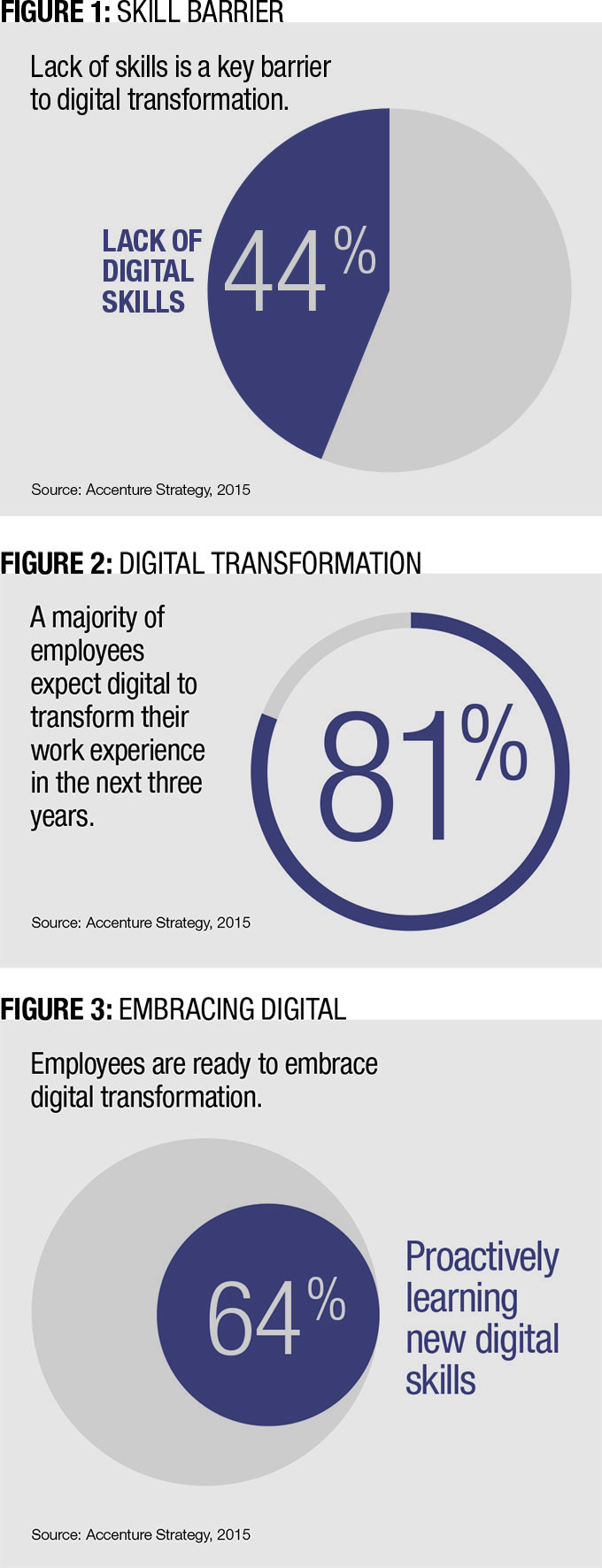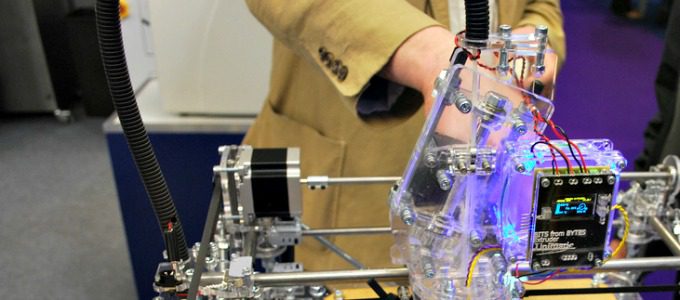In 1921, Czech playwright Karel Capek wrote a play that would change forever the way people looked at technology. Called “R.U.R.,” the story depicts a factory that makes machines that closely resemble human beings. Ultimately, the factory automatons rebel against their masters and wipe out humanity. Capek coined a word for these humanlike machines — robot — changing the global lexicon and creating a plot device that lives on in films like “Blade Runner,” “Ex Machina” and “Terminator.”
Despite popular culture’s legacy of doom and gloom, in reality, technology via robotics and other digital innovations is changing the way organizations learn and pass on skills vital to success. But to gain the full advantage, companies need to come to terms with the digital transformation of the workplace, and lay the foundation for the change throughout the organization.
Reshaping Work
Organizations are challenged by the changing roles, skills and technologies in an increasingly digital world. Even as business leaders signal the importance of talent to the overall success of an organization’s digital journey, they express concerns about talent readiness. In an Accenture Strategy survey, 44 percent of business leaders reported “lack of skills” as a key barrier to digital transformation (Figure 1) (Editor’s note: The authors work for Accenture Strategy). Only 49 percent said they already have a strategy to manage and develop skills and talent in a digital world.

While the skills and capabilities required will vary based on industry and role, some factors are broadly relevant. Employees will need to be comfortable working with technology, such as sophisticated mobile devices that support field force workers, technicians and engineers. And as more basic tasks are automated, workers can expect to take on higher value roles that require data collection, data analysis and problem-solving skills.
Foundational skills also will be in high demand, including strong business acumen and communication and negotiation skills. Further, new jobs are being created with their own specialized skill sets, such as digital copywriters, scrum masters in information technology and digital product managers.
Things like virtual sensors, analytics, advanced robotic devices, developments in artificial intelligence, automated virtual assistants, 3-D printers, wearable devices, collaboration software and gaming capabilities are reshaping work practices and the way employees learn like never before. How much? Pilots show plant workers can gain 1½ hours per day in work time using mobility enabled, electronic work packages, boosting productivity up to 25 percent.
In auto manufacturing trials, human-robot teams have assembled car frames 10 times faster than a team of three humans. How? For simple welds, a robot with a video projector teaches its human counterpart, showing them where to place a specific part; then the robot makes perfect welds in five seconds per weld. For more difficult welds, however, the robot defers to its human partner to perform better. Ultimately, the accelerated assembly speed frees up time for workers to focus on trouble-shooting and more challenging work.
Advances like these lead to greater levels of on-the-job training and empower the people who use the technology. Technology allows leaders to make more strategic decisions at a local level and frees up workers’ time to focus on higher level tasks. This approach also allows the workforce to collaborate better with one another and with machines to boost productivity and ultimately improve organizational performance.
Tearing Down Old School Structures
Alexis de Tocqueville wrote, “Nothing tends to materialize man, and to deprive his work of the faintest trace of mind, more than extreme division of labor.” What was true nearly 200 years ago is still true today: The very concept of a job — and the strict division of work — can effectively kill autonomy, inspiration, innovation and increase monotony, making tasks seem less significant and meaningful.
Now, digital is tearing down the hierarchy, bureaucracy and functional silos that have been pillars in organizations since the dawn of the Industrial Revolution. Functional roles and rigid job descriptions are giving way to people coalescing around joint goals and forming collaborative teams. This, in turn, enables the flow of critical information throughout organizations. These new ways of working promote feedback, learning and innovation at all levels.
Accenture Strategy research of European workers found that a vast majority of employees (81 percent) acknowledge that digital technologies will transform the way they work in the next three years (Figure 2). Half of that percentage say the level of transformation will be to a significant extent. Employees know they need to adjust — but more than half fear their leaders are not ready.
Rather than sitting still and waiting for transformation to happen, employees are honing their own skills and capabilities in readiness. Sixty-two percent said they are assessing the new skills and capabilities that will be required of them in the future. Almost two-thirds (64 percent) said they are proactively learning new digital tools and technical skills to prepare them to adapt to digital advances (Figure 3).
Water is an apt analogy for the effect of digital on an organization. Like a liquid, digital technology flows throughout every nook and cranny in a company. And like drops of water that over time turn stones into pebbles, digital wears down siloes and hierarchies, only a lot faster. It also hastens the organizations evolution into more flexible and networked forms.
Like a river, digital connects people across geographies and functions. It makes work processes more transparent and encourages the intersection of people and ideas that can lead to knowledge transfer that gives rise to breathtaking innovation. It helps grow complex ecosystems of vendors and alliance partners by dramatically reducing the cost of collaboration.
Because of its fluid nature, digital encourages and even requires a more “horizontal” form of leadership, meaning the ability to exercise influence without formal authority. Horizontal leadership encourages collaboration and decentralized decision-making — vital elements in a digital enterprise. Indeed, skill in horizontal leadership is what enables executives to let go and trust that effective work can be conducted by teams and that effective decision-making can be carried out at the edges of the organization.
Fundamental Changes
The shift to horizontal leadership is clear: 58 percent of executives felt technology improved communications by allowing them to connect with a team, or a broader organization, more easily and quickly. High-performing companies that have invested in collaborative tools like interactive portals, social networking, SharePoint and wikis and have found them to be 80 percent effective at improving productivity.
To adapt to the changes digital is bringing to today’s workforce, to become more agile, accommodate changing worker demands and help employees prepare for the transformation, organizations will need to adopt the following three strategies:
- Encourage talent to regularly refresh their skills. As the workplace changes, so do the profiles for workers and the skills they need to succeed. Coach and enable employees to constantly develop new skills the organization needs and seek out new opportunities to create value. Have them focus on human skills that will reign in the age of the machine — developing capabilities machines aren’t likely to take over: ideation, communication, analysis, experimentation and the ability to make sense of data.
- Flatten hierarchies. Advances don’t just come in the form of technology. It’s also time to shake up organizational structure and exercise influence without formal authority. This transition encourages collaboration and learning. Across the enterprise, including third-party suppliers and independent agents, this breaking down of silos eventually allows workers to hone specialized skills and define their own jobs.
- Embrace digital tools and technologies. Robotics, automation, technological augmentation and collaboration tools are here to stay. Embrace them proactively instead of playing catch-up to competitors that have already improved the work experience through digital — and gained the advantages.
Elon Musk, inventor and CEO of Tesla Motors, and English theoretical physicist and cosmologist Stephen Hawking have both expressed fears about the trajectory of artificial intelligence. Hawking went as far as to say, “the development of full artificial intelligence could spell the end of the human race,” ostensibly confirming the prophecy held in the works of Čapek from nearly a century ago.
But today’s machines are proving to be more friend than foe. Through digital, people can co-create highly personalized work experiences and lead and manage in ways that free employees to exercise judgment and unleash their creativity at all levels of the organization. Leaders will need to loosen the old school “command and control” grip on hierarchies and instead manage networks of employees and external talent pools, often at the far ends of, or outside the organization altogether.
Digital isn’t a cure-all. But organizations that embrace these changes from leaders down to front-line workers will be able to enjoy more engaged, satisfied employees, improve workforce productivity and effectiveness, and achieve new levels of meaning, innovation, agility and operational excellence.















